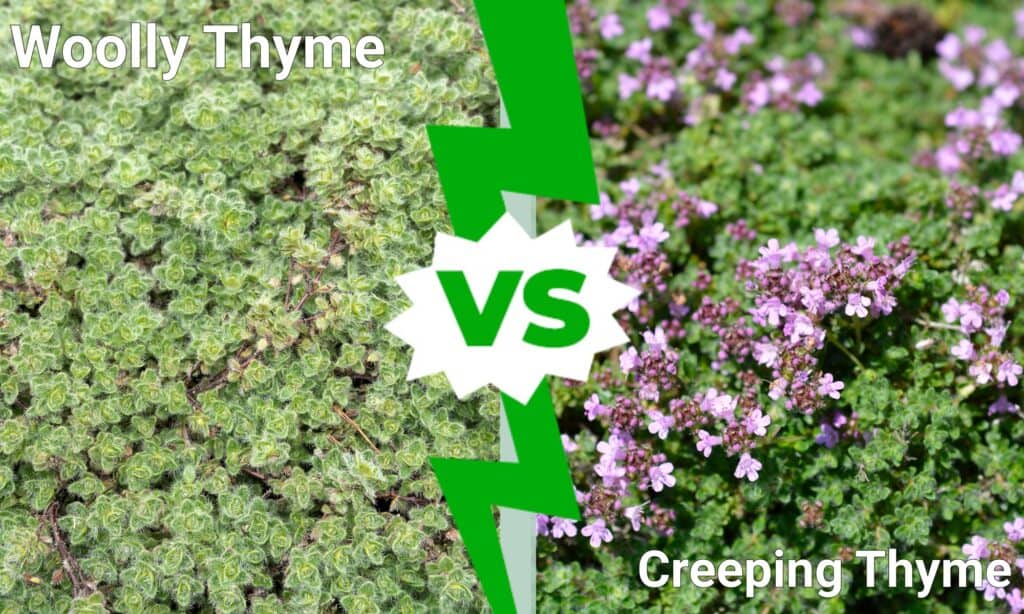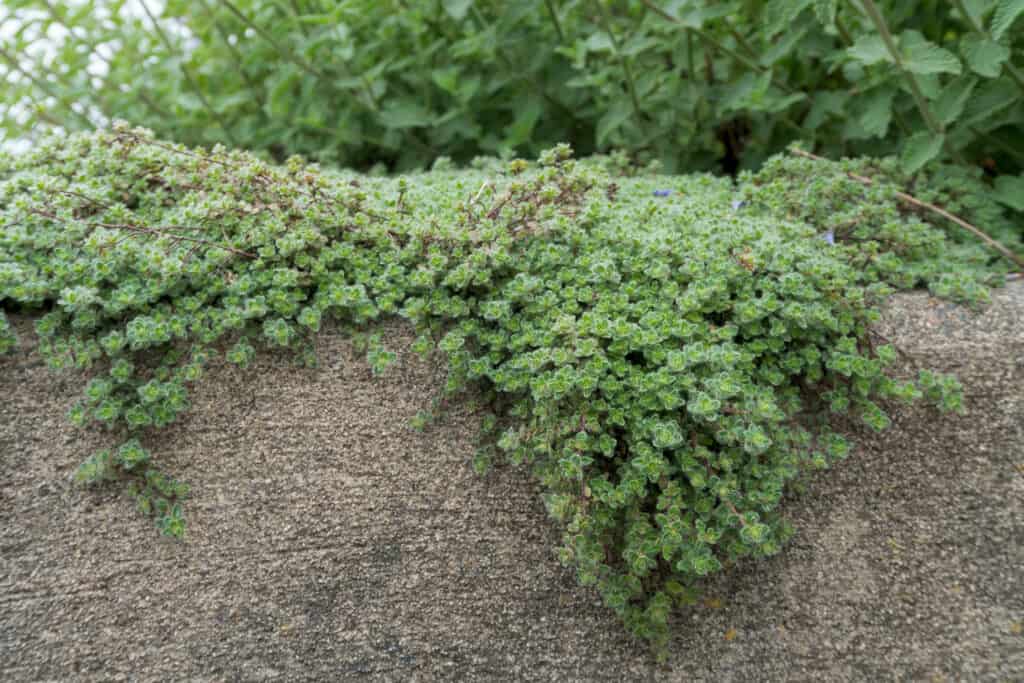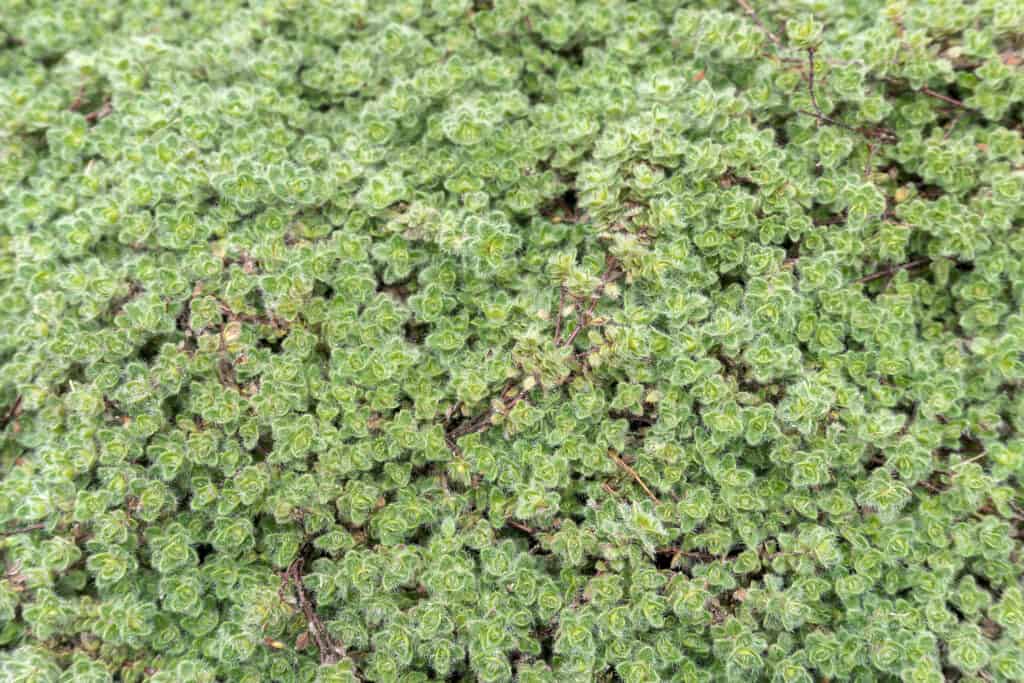Woolly thyme and creeping thyme are both ground-covering plants that smell divine and spread out to protect soil from the elements, but there are a few small differences that set them apart. Let’s take a look at the variations between woolly thyme vs creeping thyme.
What’s the Difference Between Woolly and Creeping Thyme?

The main difference between the two is their foliage. As its name suggests, woolly thyme has gray, fuzzy foliage, whereas creeping thyme’s foliage is silvery-green and almost smooth. A second difference is their flowering habit. Creeping thyme is a prolific flowerer, but woolly thyme often doesn’t bloom at all.
| Name | Creeping Thyme (Thymus serpyllum) | Woolly Thyme (Thymus pseudolanuginosus) |
| Annual or Perennial | Perennial | Perennial |
| Foliage | Small, silver-green and fragrant | Small, gray-green and woolly; little fragrance |
| Flowers | Tiny and bright pink; prolific flowerer | Tiny and bright pink but it often doesn’t bloom |
| Hardiness Zone | 5-11 | 5-11 |
| Growing Stance | One to two inches tall and horizontally branching | One to two inches tall and horizontally branching |
Creeping Thyme
Creeping thyme (Thymus serpyllum) is a species of thyme in the Lamiaceae family. It branches horizontally to hug the ground rather than growing upright like culinary thyme.
Creeping thyme is a woody perennial herb that’s edible and does a great job of protecting soil. You can walk over it to a certain extent and some gardeners like to grow it as lawn instead of grass.
Woolly Thyme
Woolly thyme is a variety of creeping thyme also in the Lamiaceae mint family that grows horizontally. Its scientific name has changed over the years due to confusion with other very similar thyme species. It’s known as Thymus pseudolanuginosus, but was once called Thymus languinosus and has a synonym Thymus praecox subsp. brittanicus.
Woolly Thyme vs. Creeping Thyme: Origins
Thyme is native to Europe, particularly the Mediterranean. It’s a real heat lover and has been used by ancient civilizations for thousands of years as food, ornamentation, and medicine. The ancient Greeks believed thyme brought courage on the battlefield and the Egyptians used it to embalm mummies. Experts think the Romans took thyme across Europe as they invaded and from there it spread to the Americas.
In modern times, thyme has been cultivated to produce many different cultivars with different blooms, scents, and growing habits. More recently, thyme has fallen under the spotlight for its medicinal activity. You can read the Journal of Medicine and Life investigation of thyme oil’s potential antiseptic properties in this article.
Woolly Thyme vs. Creeping Thyme: Foliage

Woolly thyme, which looks fuzzy from a distance, grows well spilling over walls.
©iStock.com/JPLDesigns
Woolly thyme is the woolliest and grayest of all the thymes and it looks fuzzy from quite a distance. It’ll grow to just a few inches in height and spread over 1 to 3 feet to form a dense, ground covering mat of fluffy slightly fragrant leaves. It’s a great filler between paving slabs, along pathways and spilling over walls.
In contrast, creeping thyme has lighter, greener foliage and its leaves are smaller than woolly thyme’s leaves. Whereas woolly thyme’s leaves are matte, creeping thyme tends to have a silvery sheen. It’ll reach around 1 to 2 inches in height and spread over just 1 foot, so it’s not as wide as woolly thyme.
Woolly thyme’s foliage is less fragrant than creeping thyme, but neither of them are much good for cooking. If you want to use thyme in the kitchen, choose culinary thyme as this has a much stronger scent and taste. On top of this, creeping thymes have miniature leaves, which are very tedious to harvest.
Woolly Thyme vs. Creeping Thyme: Flowers

Creeping thyme flowers prolifically in the late spring and blooms all summer.
©Henrik_L /Shutterstock.com
Woolly thyme is not a profuse bloomer and sometimes won’t flower at all, so it’s favorite with people who are allergic to bee stings. When it does flower in late spring to summer its blooms are tubular and bright pink. However, the cultivar Hall’s woolly thyme is a profuse flowerer, so don’t get them mixed up!
In contrast, creeping thyme’s flowers are numerous. They emerge in late spring and flower all summer in a bright carpet of vivid pink.
Pollinators love thyme flowers, no matter what the species or cultivar. Wildlife-friendly gardens can take advantage of thyme’s multitude of tiny flowers to feed the bees and have their fruit and vegetable plants pollinated efficiently.
Do Woolly Thyme and Creeping Thyme Smell Different?
Both species of thyme have that unmistakable thyme scent, but creeping thyme is stronger. Woolly thyme has barely any fragrance.
Which Thyme Is Best for Ground Cover?
Woolly thyme is better for in between flagstones or in tight spaces. It’s slower growing than thymus serpyllum so it won’t swallow up your pathways and stepping stones.
Creeping thyme is hardier under foot, so this is the one for alternative bee-friendly lawns and light footfall areas.
Does Woolly Thyme or Creeping Thyme Choke Out Weeds?

The density of woolly thyme’s foliage allows it to stop the growth of weeds.
©iStock.com/JPLDesigns
Creeping thyme’s dense foliage creates a mat, effectively suppressing the growth of weeds.
Similarly, the density of woolly thyme’s foliage means that it can choke out slow growing annual weeds as it spreads.
Is Woolly Thyme the Same as Creeping Thyme?
No, woolly thyme is species of thyme with horizontal branches that cover soil. It’s not the same genus as creeping thyme thymus serpyllum, but they are very similar.
How to Grow Creeping Thyme
All species of thyme are grown in the same conditions, so it’s easy to care for creeping thyme and woolly thyme.
The most important aspects are lots of sunshine and very well-drained soil. Thyme is pretty drought-hardy because it’s native to the sunny Mediterranean. Too much moisture leads to root rot so choose a sunny border or a well-drained container and only water it when the soil is drying out. Poor soil is just fine. Thyme likes a chalky or sandy home because moisture quickly runs off its roots.
A good tip is to pour water around the roots, not on the foliage as this can lead to mould and fungus.
USDA Growing Zones for Creeping and Woolly Thyme
Creeping thyme and woolly thyme are hardy herbs if they get enough sun and have well-drained roots.
Woolly thyme is a perennial that grows in zones 5-7 in full sun, but zones above may be a touch too hot in midsummer. You can still grow it there, but it will need partial shade.
Creeping thyme is also a perennial and has the same growing requirements.
Will Woolly or Creeping Thyme Survive Winter?
In zones 5 and above, creeping thyme and woolly thyme can survive winter with a little help.
As winter draws near, clip back new growth to encourage lots of air circulation around the crown. If you can, mulch the roots to keep the worst of the rain at bay.
In zone 4 and below thyme struggles to survive, but you could treat it as an annual by replacing it each year. If you’d like to save your woolly or creeping thyme, dig it up and pop it on a warm, sunny windowsill for the winter. It can go back outside when the frosts have passed.
Should I Cut Back Woolly Thyme and Creeping Thyme?

Creeping thyme clippings can be dried and used to enhance food or brew a nice tea.
©iStock.com/MarinaParshina
Yes, you can cut back both species as and when you want to. It’s very easy to prune them, just take garden shears and clip off the new growth. It’s best to cut back creeping thymes a maximum of twice a year in spring and fall.
The clippings won’t be a tasty or fragrant as culinary thyme, but you can still use them to enhance your food or dry them for a later date.
Do Woolly Thyme or Creeping Thyme Attract Animals?
Like other members of the mint family, creeping thyme is a magnet for honey bees and wild bees. Its purple flowers attract butterflies. In other good news for gardeners: as this plant wards off deer and rabbits, wherever it grows in your garden or yard it will be protected.
Woolly thyme is also attractive to bees and resistant to deer and rabbits.
Is Woolly Thyme or Creeping Thyme Toxic to Dogs?

Neither creeping thyme nor woolly thyme pose a threat to pet dogs and cats.
©iStock.com/Orest Lyzhechka
Creeping thyme and woolly thyme are not toxic to dogs, cats or horses according to the ASPCA. In fact, thyme’s essential oils have lots of excellent health properties. It’s never a good idea to let pets chew on garden plants, so use a thyme supplement if you want to boost your pet’s health.
How Do You Pronounce Thyme?
Creeping thyme is pronounced the same way as culinary thyme, as “time.” Its name originates from the ancient Greek word thuein, which means burn or sacrifice. It gets its name due to the Greeks burning thyme in their temples as an offering to their gods.
Which Is Best: Woolly Thyme or Creeping Thyme?
Woolly thyme vs creeping thyme is a hard question because they are very similar plants, however, if you’re looking to fill the cracks around paving slabs or cover the top of a wall then woolly thyme is denser and slower-growing. If you’re after thyme that’ll quickly fill up a lawn, border, or container, then creeping thyme might be a better choice.
If you’re a flower lover, bear in mind that creeping thyme serpyllum has lots of flowers in summer, but woolly thyme is a little reticent in that department!
The photo featured at the top of this post is © iStock.com/Andrii Kozlytskyi
Sources
- Royal Botanic Gardens, Available here: https://www.kew.org/science/collections-and-resources/data-and-digital
- USDA, Available here: https://planthardiness.ars.usda.gov/
- Nutrition Today, Available here: https://journals.lww.com/nutritiontodayonline/fulltext/2016/01000/thyme__history,_applications,_and_overview_of.10.aspx
- ASPCA, Available here: https://www.aspca.org/pet-care/animal-poison-control/toxic-and-non-toxic-plants/thyme
Thank you for reading! Have some feedback for us? Contact the AZ Animals editorial team.






